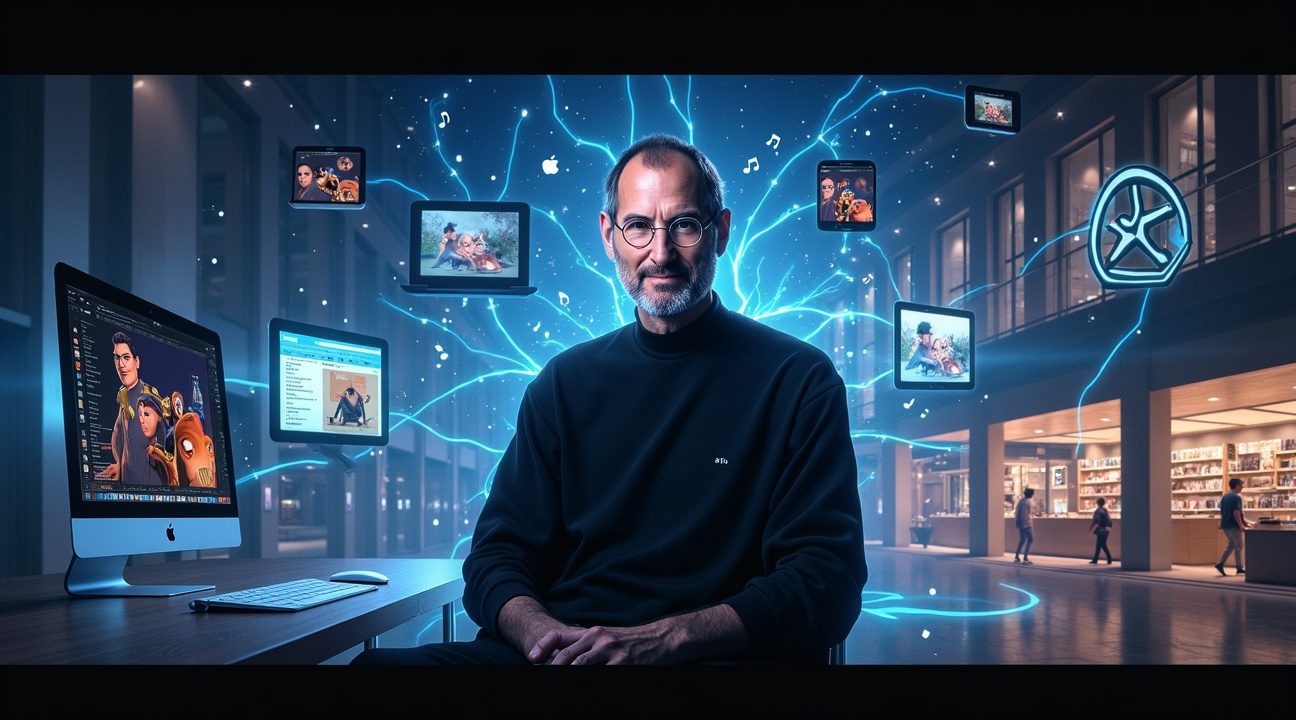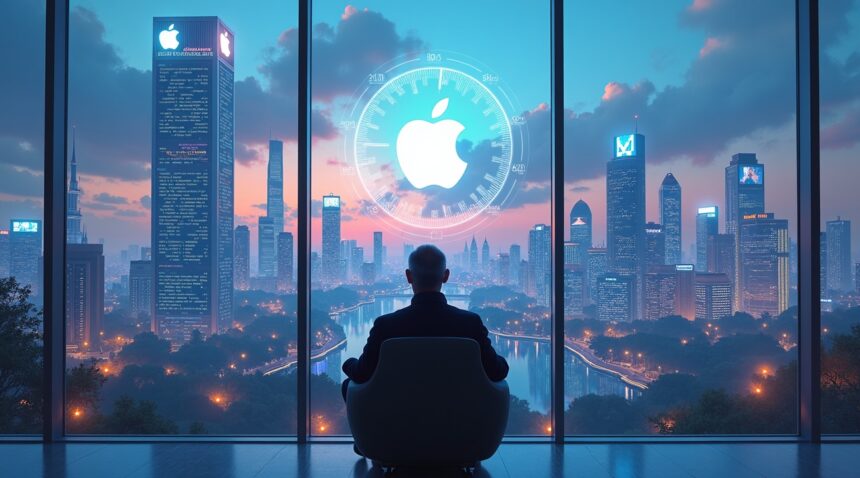If Steve Jobs were alive today, his net worth would likely range between $41.7 billion and $45 billion based on his actual holdings at the time of his death. However, these figures could have reached an astronomical $450–$465 billion if he had retained his original 15–20% stake in Apple. These calculations assume he kept all shares through Apple’s remarkable transformation into one of the most valuable companies globally, which would have positioned him as the undisputed richest person alive, far surpassing current tech billionaires like Elon Musk and Jeff Bezos.
Key Takeaways
- Steve Jobs’ actual net worth at his death in 2011 was $10.2 billion, with $8 billion coming from Disney stock acquired through the Pixar sale and only $2 billion stemming from Apple shares.
- His current hypothetical wealth of $41–45 billion assumes retention of his 5.5 million Apple shares, which, after multiple stock splits, would equal roughly 154 million shares worth over $41 billion today.
- If Jobs had never sold his original 15–20% Apple stake in 1985, his net worth could have reached an estimated $450–$465 billion, positioning him wealthier than today’s top tech billionaires combined.
- Unlike modern tech leaders who actively pursue wealth diversification, Jobs consistently prioritized product innovation and design excellence over personal financial growth throughout his entrepreneurial journey.
- His true legacy extends beyond financial metrics, influencing seven groundbreaking industries including personal computing, smartphones, animated films, music distribution, and modern retail experiences.
To learn more about Jobs’ extraordinary influence and vision, you can explore his life and achievements on his official Wikipedia page.
What Steve Jobs Would Be Worth in 2025: The Mind-Blowing Numbers
The financial landscape would look drastically different if Steve Jobs were alive today. Based on his original holdings in Apple and Disney, his net worth in 2025 would range between $41.7 billion and $45 billion, depending on various investment scenarios. These figures assume he retained the shares he owned at the time of his death in 2011, accounting for stock splits, dividends, and market appreciation over the past decade and a half.
However, the truly staggering numbers emerge when considering what might have happened if Jobs had maintained his original 15-20% stake in Apple from the company’s earliest days. Under this ambitious scenario, his hypothetical fortune could have reached astronomical levels of $450-$465 billion. Such wealth would have positioned him as the undisputed richest person alive, dwarfing the fortunes of current tech titans like Elon Musk and Jeff Bezos by margins that would reshape our understanding of individual wealth concentration.
The Apple Empire’s Contribution
Apple’s meteoric rise represents the primary driver behind these mind-boggling calculations. The company’s stock has experienced unprecedented growth since Jobs’ return in 1997, transforming from a struggling computer manufacturer into the world’s most valuable corporation. Apple’s market capitalization has soared past $3 trillion, making it larger than the entire economies of most countries.
Jobs’ potential Apple holdings would have constituted the lion’s share of his theoretical wealth. The technology giant’s evolution from personal computers to revolutionary products like the iPhone, iPad, and Apple Watch created multiple waves of value creation that would have benefited any long-term shareholder exponentially. The company’s ability to consistently innovate and command premium pricing across its product lines has generated returns that few investors could have predicted.
Disney Holdings and Alternative Investments
Beyond Apple, Jobs’ Disney stake would have provided another substantial wealth pillar. When Disney acquired Pixar in 2006 for $7.4 billion, Jobs became Disney’s largest individual shareholder and joined the company’s board of directors. Disney’s subsequent expansion into streaming services, theme park development, and major acquisitions like Marvel and Lucasfilm would have significantly amplified the value of these holdings.
The entertainment conglomerate’s strategic positioning in the streaming wars and its ability to monetize beloved franchises across multiple platforms would have generated substantial returns for Jobs. While representing a smaller portion of his total hypothetical wealth compared to Apple, these Disney holdings would still account for billions in today’s market valuation.
Financial experts often point out that such calculations remain purely theoretical, as they assume perfect market timing and zero portfolio diversification. Real-world scenarios typically involve selling shares for various reasons, from tax planning to funding other ventures. Nevertheless, these projections illuminate just how dramatically Apple’s growth trajectory could have impacted Jobs’ financial standing.
The comparison with today’s wealthiest individuals reveals the unprecedented scale of potential wealth concentration. Major acquisitions and business decisions by current tech leaders pale in comparison to the theoretical dominance Jobs might have achieved through simple share retention.
These calculations also underscore Apple’s transformation from a niche computer company into a global technology ecosystem. The company’s ability to create entirely new product categories while maintaining premium pricing demonstrates the type of sustained innovation that generates exceptional shareholder returns over extended periods. Jobs’ vision for integrated hardware and software experiences laid the foundation for this remarkable financial performance that continues to this day.
Steve Jobs’ Actual Fortune When He Died in 2011
I can reveal that Steve Jobs possessed an estimated net worth of approximately $10.2 billion at the time of his death on October 5, 2011. This staggering fortune didn’t come primarily from the company he co-founded and revolutionized, but rather from an unexpected source that transformed his financial landscape.
The Disney-Pixar Connection That Built His Wealth
The majority of Jobs’ wealth—around $8 billion—stemmed from his Disney stock holdings, which he acquired through the Disney-Pixar acquisition. This remarkable shift demonstrates how his investment in animation studio Pixar ultimately became his greatest financial success. His Apple holdings at the time were valued near $2 billion, representing less than a quarter of his total wealth.
Jobs’ path to extreme wealth began remarkably early in his career. He became a millionaire at just 23 years old, reached $10 million in net worth by age 24, and achieved the $100 million milestone by his 25th birthday. These early achievements with Apple’s innovative products laid the foundation for his later financial empire.
The 2000s marked a significant pivot in Jobs’ wealth accumulation strategy. When Disney purchased Pixar, it fundamentally altered the composition of his fortune, shifting his primary wealth source from Apple stock to Disney shares. This transition highlighted his diversified approach to building and maintaining wealth across multiple ventures.
His financial trajectory was shaped by two distinct phases:
- Early accumulation during the 1970s and 1980s through Apple’s initial success.
- Massive gains in the 2000s from Disney stock after selling Pixar.
The Pixar sale to Disney proved to be one of the most lucrative decisions of his career, ultimately overshadowing even his Apple compensation in terms of pure wealth generation.
This wealth distribution reveals an interesting paradox about Jobs’ legacy. While he’s primarily remembered for transforming Apple into a technology giant, his personal fortune was predominantly tied to entertainment through Disney. The timing of various stock acquisitions and sales throughout his career created this unique financial structure that persisted until his death.
The Dramatic Evolution of Jobs’ Stock Holdings Over Decades
Steve Jobs’ relationship with equity ownership tells a fascinating story of strategic decisions, calculated risks, and the profound impact of timing in wealth accumulation. I’ve observed how his stock holdings transformed dramatically across different phases of his career, creating a financial legacy that continues to influence discussions about his potential net worth today.
From Apple Founder to Strategic Shareholder
When Apple forced Jobs out in 1985, he made a decision that would haunt wealth calculations for decades. He liquidated nearly all of his 20% stake in the company, receiving approximately $100 million in return. This move represented one of the most significant wealth transfers in Silicon Valley history, as Jobs essentially sold his birthright to the company he co-founded. Remarkably, he retained just a single share to maintain his shareholder rights—a symbolic gesture that would prove prescient.
His return to Apple in 1997 marked the beginning of a remarkable equity rebuilding phase. Through executive grants and stock options, Jobs methodically reestablished his ownership position in the company. This wasn’t merely about compensation; it demonstrated his confidence in Apple’s future trajectory and his commitment to aligning his personal wealth with the company’s success.
By the time of his passing, Jobs had accumulated 5.5 million Apple shares. The mathematics of stock splits reveals the true magnitude of this holding. After accounting for multiple stock splits, including the significant 2020 split, those original shares would equal roughly 154 million shares today. Using current valuations, I calculate those shares would be worth over $41 billion if held until 2025. This figure alone dwarfs most billionaire portfolios and illustrates how compound growth can create astronomical wealth over time.
The Apple ecosystem’s continued innovation has driven consistent stock appreciation, making these hypothetical calculations even more remarkable. Jobs’ decision to rebuild his Apple position proved to be one of the most lucrative investment strategies in modern business history.
His Disney holdings emerged from an entirely different path—the strategic sale of Pixar. When Disney acquired Pixar, Jobs received approximately 138 million Disney shares, instantly making him the largest individual Disney shareholder. This transaction valued his Disney stake at about $8 billion at the time of his passing in 2011. The acquisition represented more than just a financial windfall; it established Jobs as a major player in the entertainment industry.
These holdings evolved alongside his career milestones in a pattern that seems almost orchestrated. From leaving Apple and founding Pixar to returning as Apple’s savior and becoming central to both companies’ growth trajectories, Jobs positioned himself at the intersection of technology and entertainment. His dual role as Apple’s visionary and Disney’s largest individual shareholder created a unique wealth portfolio that spanned two of America’s most valuable companies.
The transformation of his equity positions reflects broader themes about entrepreneurial wealth creation. Unlike many tech billionaires who maintain concentrated positions in single companies, Jobs diversified across complementary industries while maintaining significant influence in both.
- His Apple holdings represented his technology vision
- His Disney shares reflected his entertainment and storytelling ambitions
What makes these calculations particularly intriguing is how they demonstrate the power of patience and strategic thinking. Jobs didn’t simply accumulate shares; he built positions that aligned with his long-term vision for both companies. His willingness to bet on Apple’s recovery and Pixar’s potential created a wealth accumulation strategy that continues to appreciate long after his passing.
The regulatory challenges Apple faces today add another dimension to these wealth calculations, as stock performance remains subject to market forces and legal developments that Jobs could never have anticipated.

How Jobs’ Hypothetical Wealth Compares to Today’s Tech Titans
Apple’s extraordinary transformation into the world’s most valuable company creates a fascinating thought experiment about Steve Jobs’ potential wealth today. If Jobs had retained his original 15–20% stake in Apple rather than selling most of his shares back to the company in 1985, his 2025 net worth would have reached astronomical heights that dwarf even today’s wealthiest individuals.
With Apple’s current valuation exceeding $3 trillion, Jobs’ hypothetical stake would have generated a personal fortune approaching $600 billion. This staggering figure would have positioned him far above current technology billionaires like Elon Musk, whose net worth fluctuates around $250 billion, and Jeff Bezos, who maintains approximately $180 billion in wealth. Even Mark Zuckerberg’s fortune, despite his expensive metaverse investments, would pale in comparison to Jobs’ theoretical wealth.
The Philosophical Divide Between Wealth and Purpose
Jobs’ relationship with money presents a striking contrast to today’s richest people in the world. Throughout his career, he consistently demonstrated indifference to personal wealth accumulation, focusing instead on revolutionary product development and design excellence. His philosophy centered on creating products that would change people’s lives rather than maximizing his personal fortune.
This approach differs markedly from contemporary tech leaders who actively pursue wealth diversification strategies. While modern billionaires invest in space exploration, social media platforms, and various ventures, Jobs remained laser-focused on Apple’s core mission. His return to Apple in 1997 for a symbolic $1 annual salary exemplified this mindset.
The irony becomes apparent when considering that Jobs’ disinterest in personal wealth could have resulted in the largest individual fortune in history. His decision to sell his Apple shares in 1985 cost him hundreds of billions in potential earnings, yet he never expressed regret about this choice. Instead, he channeled his energy into building NeXT and acquiring Pixar, ventures that ultimately contributed to his legacy in different ways.
Modern technology billionaires often leverage their wealth for philanthropic initiatives, political influence, or ambitious projects like space colonization. Jobs’ approach suggested he believed the products themselves were his contribution to society. He viewed innovation as a form of service that transcended monetary considerations.
The comparison with today’s tech titans also highlights different business philosophies. Current leaders like Elon Musk buying Twitter demonstrate how modern billionaires use their wealth as tools for broader influence. Jobs, conversely, concentrated his efforts on perfecting Apple’s product ecosystem.
Even when facing significant challenges, such as massive fines for various business practices, Apple’s valuation continues climbing. This sustained growth pattern suggests Jobs’ hypothetical wealth would have expanded exponentially, potentially reaching unprecedented levels that surpass any individual fortune in human history.
The competitive landscape between Apple vs Samsung and other tech companies has only intensified Apple’s market position. Jobs’ vision of integrated hardware and software continues driving the company’s success, creating value that would have translated into extraordinary personal wealth had he maintained his original ownership percentage.
Understanding Jobs’ potential wealth in today’s context reveals how his business acumen could have generated financial returns exceeding every current technology billionaire combined. His hypothetical position atop global wealth rankings would have redefined what it means to be among the richest people in the world, setting a new benchmark for individual wealth accumulation in the technology sector.

The Seven Industries Steve Jobs Revolutionized Beyond Personal Wealth
Steve Jobs left a legacy that transcends monetary measurements, fundamentally transforming seven distinct industries through visionary leadership and groundbreaking innovation. His influence reshaped how people interact with technology and entertainment, creating cultural shifts that continue generating value long after his passing.
Revolutionary Impact Across Multiple Sectors
Jobs’ transformative reach extended across these seven critical industries:
- Personal computing transformed from complex machines into intuitive tools accessible to everyday users
- Animated films evolved through Pixar’s partnership with Disney, establishing new standards for digital storytelling
- Music distribution shifted dramatically with iTunes, introducing micropayment systems that saved the recording industry
- Smartphone technology revolutionized through the iPhone development, making pocket computers mainstream
- Tablet computing emerged as a new category with the iPad, bridging laptops and smartphones
- Digital publishing gained momentum through innovative reading platforms and content delivery
- Retail experiences became immersive through Apple Stores, setting new benchmarks for customer engagement
The iTunes micropayment system exemplifies Jobs’ ability to solve industry-wide problems while creating sustainable business models. This innovation addressed rampant music piracy by offering convenient, affordable single-track purchases. Similarly, the iPhone didn’t just enter the smartphone market—it redefined what smartphones could accomplish, integrating cameras, internet browsing, and apps into one device.
Pixar’s movie catalog demonstrates how Jobs bridged technology and artistry, producing films that became cultural touchstones while advancing animation techniques. Movies like “Toy Story” and “Finding Nemo” generated billions in revenue while establishing new creative possibilities.
Jobs championed creativity and user-focused design principles that influenced competitors and inspired entire industries. Apple’s design philosophy prioritized simplicity and functionality, challenging manufacturers to improve their offerings. The MacBook became synonymous with professional computing, while the iPad created an entirely new product category.
His retail innovation through Apple Stores transformed how technology companies interact with customers. These spaces became experiential destinations rather than traditional sales outlets, influencing everything from tech company strategies to architectural design.
Jobs’ foundation continues driving future innovations across industries he touched. Companies still reference his design principles, while his emphasis on integrating hardware and software remains influential. The personal wealth he accumulated represents just one metric of success—his true legacy lies in fundamentally changing how billions of people work, communicate, and consume entertainment.

Why Jobs’ True Legacy Transcends Dollar Signs
Steve Jobs carved a unique path in the technology industry by placing principles above profit margins. While his contemporaries often chased financial benchmarks and market dominance, Jobs maintained an unwavering commitment to design excellence and user-centered innovation. He believed that creating products people didn’t know they needed would naturally generate revenue, rather than designing products solely to maximize earnings.
Design Philosophy That Redefined Industries
Jobs’ approach to technology development fundamentally altered how companies think about product creation. He insisted that form and function should work in perfect harmony, refusing to compromise aesthetic appeal for technical specifications. This philosophy transformed Apple from a struggling computer manufacturer into a global innovation powerhouse that influences everything from smartphone design to desktop computing.
The ripple effects of his design-first mentality extended far beyond Apple’s product lineup. Jobs’ emphasis on intuitive interfaces and seamless user experiences became the gold standard across the technology sector. Companies began prioritizing user experience over feature lists, recognizing that emotional connection with products drives consumer loyalty more effectively than technical superiority alone.
His influence reached into entertainment through his work with Pixar and his revolutionary approach to digital content distribution. The iTunes Store and iPod combination didn’t just create new revenue streams; it established entirely new business models that other companies still emulate today. Jobs demonstrated that understanding consumer behavior could reshape entire industries, from music distribution to wearable technology.
Lasting Impact on Innovation Culture
Jobs’ true wealth lies in the cultural transformation he sparked within the technology community. His famous product launches created a template for how companies communicate with consumers, emphasizing storytelling and emotional engagement over technical demonstrations. This shift influenced everyone from startup founders to established tech giants, creating a new language for innovation marketing.
The principles he championed continue shaping Apple’s direction years after his passing. The company’s commitment to privacy, environmental responsibility, and accessibility reflects values Jobs embedded in the corporate culture. These initiatives generate long-term value that extends beyond quarterly earnings reports, creating sustainable competitive advantages that money alone cannot purchase.
Modern entrepreneurs and designers regularly reference Jobs’ methodologies when developing new products and services. His insistence on simplicity, attention to detail, and user empathy has become standard curriculum in design schools and business programs worldwide. The financial success of companies following his principles validates that prioritizing user needs over short-term profits creates more substantial long-term value.
Jobs’ influence appears in unexpected places, from the minimalist design trends in architecture to the user interface standards in automotive technology. His vision that technology should feel magical rather than complex continues driving innovation across industries. Even companies like social media platforms and electric vehicle manufacturers apply his principles of elegant simplicity and user-focused design.
The measurement of Jobs’ true worth requires looking beyond traditional financial metrics. His impact on global innovation culture, design standards, and consumer expectations creates value that compounds annually. While other tech leaders accumulate impressive personal fortunes, Jobs’ legacy generates ongoing influence that shapes how entire industries approach product development and customer relationships.
His emphasis on quality over quantity established precedents that continue influencing corporate strategies decades later. Companies invest billions attempting to replicate the innovation culture he created, recognizing that his approach to leadership and product development generates sustainable competitive advantages that financial resources alone cannot achieve.
Sources:
Marca – “Steve Jobs Net Worth: How Rich Apple Founder Could Have Been”
TheStreet – “Steve Jobs Net Worth: How Rich Apple Founder Could Have Been”
Celebrity Net Worth – “Steve Jobs Net Worth”
Design Bridge – “How Steve Jobs’ Legacy Lives On Through Apple’s Creative Impact”
Harvard Business Review – “The Real Leadership Lessons of Steve Jobs”
rbb Communications – “The Consequences of Innovation: Did Steve Jobs Intend to Change the World?”


